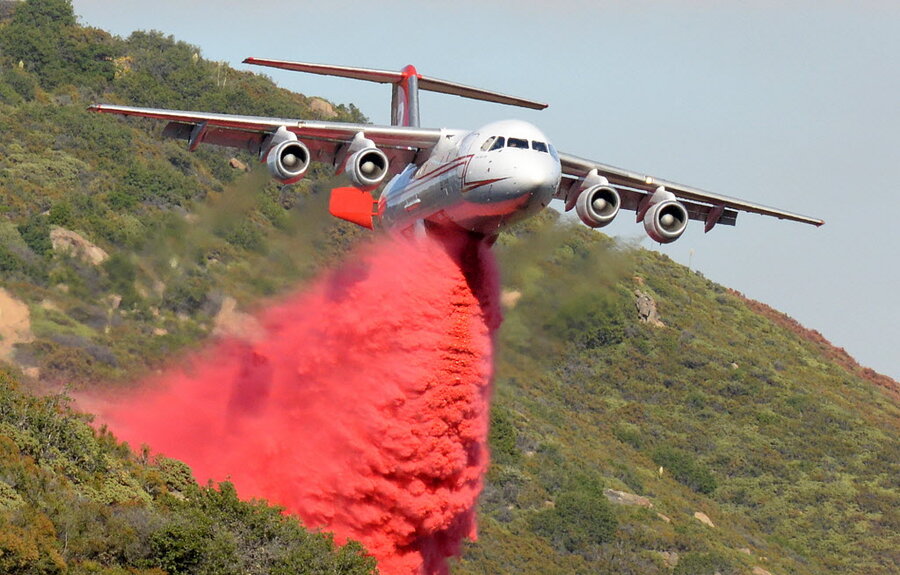Record heat sparks warnings, boosts fires in western United States
Loading...
| Los Angeles
Fire warnings were in place across three western U.S. states on Sunday as record-breaking heat threatened to feed wildfires that have blackened thousands of acres (hectares), especially in California and New Mexico.
The National Weather Service said temperatures of 120 Fahrenheit (49 Celsius) were possible in southwestern deserts through Wednesday.
"Red flag warnings" for potential fires covered an area stretching across southern California, southern Nevada and southern Arizona.
"These extreme temperatures can be life-threatening," the weather service said on its website. The high temperatures have joined with a prolonged dry spell to worsen the fire threat.
The agency declared an elevated threat in California's Santa Barbara County from dry conditions and evening winds. More than 2,000 firefighters there are battling the so-called Sherpa Fire, which had burned 7,811 acres (3,161 hectares) in coastal canyons.
A wildfire that for days has threatened hundreds of homes and popular seaside campgrounds near Santa Barbara was half-surrounded and held in check, though firefighters were about to face the hottest day yet and the kind of dry, torrid conditions prevailing from the West Coast all the way to New Mexico.
A Red Flag warning for late Sunday and early Monday, signaling dangerously dry heat and high winds, was declared for the hilly coastal area west of Santa Barbara.
The fire was 51 percent contained after burning more than 2 square miles since starting on Wednesday.
Meanwhile near downtown Los Angeles, a small-but-dangerous brush fire threatened a densely populated, hilly neighborhood along a freeway amid sizzling temperatures Sunday.
Crews knocked down the blaze in the Silver Lake neighborhood after it damaged two homes, destroyed three shed-like structures, scorched yards and sent trees up in flames.
Neighbors scrambled with garden hoses and buckets, while water-dropping helicopters and scores of firefighters chased embers and doused steep hillsides to keep the flames from spreading.
The blaze only charred 8 acres but gave urban residents a scare.
Paul Gaffner had been swimming at a pool a few minutes from his home and was planning to run errands when he saw heavy smoke near his house.
"Man, that fire is at my house," he said he thought.
When he arrived, his neighbor was hosing down flames in his backyard. In his flip-flops and shorts, he joined the fight as neighbors chipped in help protect their houses.
"It was a lot going on," Gaffner said as he handed out bottles of Gatorade to firefighters. "You've got it in front of you, you don't have time to panic."
Another wildfire that broke out Sunday forced the evacuation of about 75 people from a tiny town in the California desert near the Mexico border.
It had surged to over 2 square miles amid triple-digit temperatures near the town of Potrero, a ranching community just a few miles north of Tecate, Mexico, and about 40 miles southeast of San Diego.
In New Mexico, a 28-square-mile fire that erupted last week and destroyed 24 homes in the Manzano Mountains south of Albuquerque was largely uncontained. But higher humidity overnight allowed crews to strengthen lines around the fire and keep a lookout for hot spots where flames could jump the line.
Another blaze, the Dog Head Fire, southeast of Albuquerque, New Mexico, has destroyed about two dozen homes and forced evacuations.
Almost 1,000 personnel were fighting the blaze that has burned through about 17,615 acres (7,129 hectares) of timber and logging zones.
In Alaska, a fire warning was also in place for the eastern part of the Alaska Range, with winds forecast to gust to 60 miles per hour (96 km per hour).
Saturday's high temperature was 112F (44C) at Death Valley, California, the weather service said.
(Reporting by Ian Simpson in Washington; Editing by Andrew Bolton)







